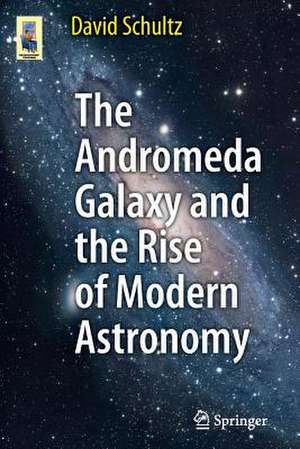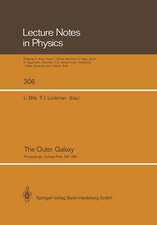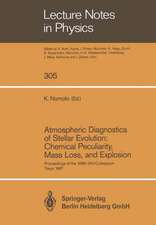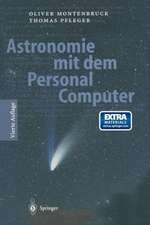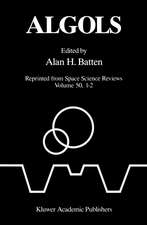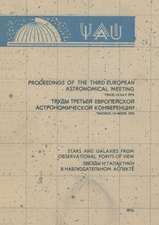The Andromeda Galaxy and the Rise of Modern Astronomy: Astronomers' Universe
Autor David Schultzen Limba Engleză Paperback – 2 apr 2012
While at the start of the twentieth century the universe was thought of as a finite cosmos dominated by the Milky Way, the study of Andromeda galaxy shattered that image, leading ultimately to the conception of an infinite universe of countless galaxies and vast distances. Even today, M31 is a major focal point for new astronomical discoveries, and it also remains one of the most popular (and rewarding) celestial objects for amateur astronomers to observe and study. This book reveals the little-known history of M31 and the scientists who study it.
For all who are interested in astronomy, the skies, and perhaps even the origins of the universe, The Andromeda Galaxy and the Rise of Modern Astronomy provides a first-of-its-kind accessible, informative, and highly readable account of how the study and observation of this celestial object has driven the development of astronomy from ancient times to the present.
Din seria Astronomers' Universe
-
 Preț: 210.44 lei
Preț: 210.44 lei -
 Preț: 207.15 lei
Preț: 207.15 lei -
 Preț: 195.53 lei
Preț: 195.53 lei -
 Preț: 254.90 lei
Preț: 254.90 lei -
 Preț: 212.88 lei
Preț: 212.88 lei -
 Preț: 256.41 lei
Preț: 256.41 lei -
 Preț: 264.35 lei
Preț: 264.35 lei -
 Preț: 259.08 lei
Preț: 259.08 lei -
 Preț: 227.61 lei
Preț: 227.61 lei -
 Preț: 277.98 lei
Preț: 277.98 lei -
 Preț: 305.70 lei
Preț: 305.70 lei -
 Preț: 253.11 lei
Preț: 253.11 lei -
 Preț: 216.60 lei
Preț: 216.60 lei -
 Preț: 272.24 lei
Preț: 272.24 lei -
 Preț: 330.75 lei
Preț: 330.75 lei -
 Preț: 179.00 lei
Preț: 179.00 lei -
 Preț: 289.83 lei
Preț: 289.83 lei -
 Preț: 160.03 lei
Preț: 160.03 lei -
 Preț: 200.80 lei
Preț: 200.80 lei -
 Preț: 255.97 lei
Preț: 255.97 lei -
 Preț: 242.58 lei
Preț: 242.58 lei -
 Preț: 262.55 lei
Preț: 262.55 lei -
 Preț: 282.38 lei
Preț: 282.38 lei -
 Preț: 187.82 lei
Preț: 187.82 lei -
 Preț: 225.19 lei
Preț: 225.19 lei -
 Preț: 207.64 lei
Preț: 207.64 lei -
 Preț: 104.35 lei
Preț: 104.35 lei -
 Preț: 188.94 lei
Preț: 188.94 lei -
 Preț: 270.50 lei
Preț: 270.50 lei -
 Preț: 212.01 lei
Preț: 212.01 lei -
 Preț: 169.08 lei
Preț: 169.08 lei -
 Preț: 210.01 lei
Preț: 210.01 lei -
 Preț: 208.26 lei
Preț: 208.26 lei -
 Preț: 253.98 lei
Preț: 253.98 lei -
 Preț: 180.12 lei
Preț: 180.12 lei -
 Preț: 280.19 lei
Preț: 280.19 lei -
 Preț: 273.13 lei
Preț: 273.13 lei -
 Preț: 207.39 lei
Preț: 207.39 lei -
 Preț: 208.70 lei
Preț: 208.70 lei -
 Preț: 214.86 lei
Preț: 214.86 lei -
 Preț: 188.94 lei
Preț: 188.94 lei -
 Preț: 194.65 lei
Preț: 194.65 lei -
 Preț: 277.34 lei
Preț: 277.34 lei -
 Preț: 187.15 lei
Preț: 187.15 lei -
 Preț: 210.93 lei
Preț: 210.93 lei -
 Preț: 212.01 lei
Preț: 212.01 lei
Preț: 284.56 lei
Nou
Puncte Express: 427
Preț estimativ în valută:
54.45€ • 57.26$ • 44.99£
54.45€ • 57.26$ • 44.99£
Carte disponibilă
Livrare economică 27 martie-10 aprilie
Preluare comenzi: 021 569.72.76
Specificații
ISBN-13: 9781461430483
ISBN-10: 1461430488
Pagini: 283
Ilustrații: XII, 271 p. 139 illus., 72 illus. in color.
Dimensiuni: 155 x 235 x 15 mm
Greutate: 0.54 kg
Ediția:2012
Editura: Springer
Colecția Springer
Seria Astronomers' Universe
Locul publicării:New York, NY, United States
ISBN-10: 1461430488
Pagini: 283
Ilustrații: XII, 271 p. 139 illus., 72 illus. in color.
Dimensiuni: 155 x 235 x 15 mm
Greutate: 0.54 kg
Ediția:2012
Editura: Springer
Colecția Springer
Seria Astronomers' Universe
Locul publicării:New York, NY, United States
Public țintă
Popular/generalCuprins
Chapter 1: The Wonder of Andromeda Galaxy.- Chapter 2: Early Depictions of Andromeda.- Chapter 3: A Single Closed Theory of the Universe.- Chapter 4: Andromeda and the Technological Revolution in Astronomy.- Chapter 5: Andromeda and Astronomy at the Beginning of the Twentieth Century.- Chapter 6: The Andromeda Nebula and the Great Island-Universe Debate.- Chapter 7: Edwin Hubble, an Infinite Universe, and the Classification of Galaxies.- Chapter 8: Andromeda, Galactic Redshift, and the Big Bang Theory.- Chapter 9: Andromeda, Cosmology, and Post-World War II Astronomy.- Chapter 10: Astronomy and Andromeda at the Close of the Twentieth Century.- Chapter 11: The Andromeda Galaxy.- References.- Andromeda Statistics.- Index.
Notă biografică
David Schultz is an avid amateur astronomer with a master's degree in astronomy from James Cook University. He is a Hamline University professor in the School of Business, where he teaches classes in government ethics, public policy, and public administration. He also holds appointments at the Hamline University and Minnesota schools of law, where he teaches election law, professional responsibility, and state constitutional law. Professor Schultz is the author of more than 25 books and 80 articles. In addition to a degree in astronomy, he has a Ph.D. in political science and a law degree from the University of Minnesota, a masters of law from the University of London, a masters degree in political science from Rutgers University, a masters degree in philosophy from Binghamton University, and a bachelors degree in political science and philosophy from Binghamton University.
Textul de pe ultima copertă
The Andromeda Galaxy - Messier's M31 - has an almost romantic appeal. It is the most distant object and the only extragalactic object that is visible to the unaided human eye. It is also almost a twin of the Milky Way Galaxy and our neighbor in space, now known to be about 2.5 million light-years away. The Andromeda Galaxy and the Rise of Modern Astronomy examines ancient and modern astronomical studies of Andromeda and the galaxy's critical role in the development of the science of astrophysics and our growing knowledge of the universe.
At the start of the twentieth century the universe was thought of as a finite cosmos dominated by the Milky Way. The study of Andromeda shattered that image, leading ultimately to the conception of an infinite universe of countless galaxies and vast distances. Even today, M31 is a major source of new astronomical discoveries, and it also remains one of the most popular (and rewarding) celestial objects for amateur astronomers to observe and study.
Andromeda was once a popular object of folklore and later became central to our understanding of the universe. For all who are interested in astronomy, the skies, and perhaps even the origins of the universe, The Andromeda Galaxy and the Rise of Modern Astronomy provides a first-of-its-kind accessible, informative, and highly readable account of how the study and observation of this celestial object has driven the development of astronomy from ancient times to the present.
At the start of the twentieth century the universe was thought of as a finite cosmos dominated by the Milky Way. The study of Andromeda shattered that image, leading ultimately to the conception of an infinite universe of countless galaxies and vast distances. Even today, M31 is a major source of new astronomical discoveries, and it also remains one of the most popular (and rewarding) celestial objects for amateur astronomers to observe and study.
Andromeda was once a popular object of folklore and later became central to our understanding of the universe. For all who are interested in astronomy, the skies, and perhaps even the origins of the universe, The Andromeda Galaxy and the Rise of Modern Astronomy provides a first-of-its-kind accessible, informative, and highly readable account of how the study and observation of this celestial object has driven the development of astronomy from ancient times to the present.
Caracteristici
An absorbing account of the Milky Way's "galactic twin" Describes how the study of Andromeda Galaxy has led to our current understanding of the nature of the universe and drastically increased our knowledge of the cosmos Focuses on the Andromeda Galaxy from ancient times to the present Draws upon scientific knowledge, amateur astronomy, and pop culture accounts of Andromeda Galaxy to tell the history of astronomy Discusses how new technologies used to study Andromeda have been deployed to explore other objects and expand our knowledge of the Milky Way and the universe Shows how the study of the Andromeda Galaxy was at the center of some of the most contentious debates in astronomy
